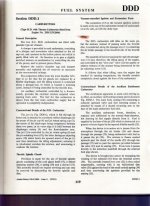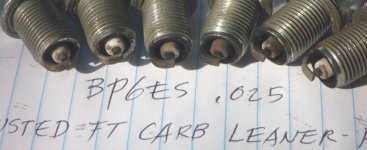Offline
On another thread about spark plugs we started a conversation about getting 400 rpm idle out of HD8 carbs. Because the HD8 carbs are suppose to run at idle with the throttle plates completely closed, as per the Bentley Manual, I find that i easily can achieve a 400 rpm idle IF I KEEP THE THROTTLE PLATES COMPLETELY CLOSED. That's the key. The HD8s were designed to idle on the amount of fuel/air that is by-passed around the closed throttle plates and restricted or regulated by the slow run valve. This is nothing more than a passageway around the throttle plates with a tapered needle point screw threaded into the passageway to regulate the amount passing thru. With the jet set to as close to the correct mixture as possible (using the jet adjusting screw) it is only necessary to turn in or out the slow run screw to achieve the desired idle speed. The manual states that the slow run screw is usually set at about 2 1/4 turns from bottom and if after tuning the carb one finds that the idle speed is too fast it is only necessary to turn in the slow run screw a bit to achieve the desired idle speed. (remember the throttle plates are completely closed). BUT IN REALITY THIS IS WHAT i HAVE ACTUALLY FOUND, in my case with my car I have found that I am not getting enough "flow" via the slow run screws alone. But I am getting enough "flow" to sustain about 400 rpms. But the drawback to this I think I am discovering is that I can't run the jet as rich as should be and am forced to keep it alittle lean. And this is the way I have been running it most of the summer. But about 3 weeks ago I decided I wanted to up the RPMs and also richen the mixture. To achieve the 400 rpm idle on the slow run screws alone, I had the slow run screws turned out to about 3 1/2 turns. Bringing them out more did not help the idle at all. But maybe increasing the richness of the jet would have yielded more rpm. I tried different jet and slow run settings and never got a good idle above 400 rpms. So I finally gave in and decided to crack the throttle plates just a tesch. So you realize this is going to allow more fuel/air around the plates and down the bore. So I set both the throttle plates just a smidgin of a bit open using the throttle shaft screws. Now I again fine tuned my idle by using the slow run screws. By this method I am compromising the system by allowing mixture to go around the plates and then also adjusting the slow run screws. With this method I can achieve any idle speed I want, and in this configuration with the slow run screws at about 3 turns out (a point near what they were before) the engine is idling at about 700 rpms. I will try to attach an exert from the Bentley Manual. But one more thing I would like to explain which might be relevant to your higher idle speed. Some years ago before I took my car apart for restoration, I was driving it regularly for 7 summers. I could never get the idle down much lower than about 900 rpms. The slow run screws pretty much did nothing, had no effect. So I turned the slow run screws all the way down tight. Pretty much taking that passage out of commission. Then I adjusted my HD8 carbs the same as the way you would adjust the earlier SUs. Set the jet height, balance the carbs and then set idle with the throttle shafts. But I couldn't understand why the slow run screws had no effect. When I took the carbs off during restoration I found that the diaphragm on the rear jet was very stiff and it never let the jet return to its most upward position there-by causing that carb to be rich all the time. This caused the whole adjustment of both carbs to be off and this is why I never could get the engine to idle below 900 rpms. With the jet being very rich, you needed more flow to compensate er go more rpms. Well I guess I have pretty much blown this one out of the water, maybe some of this diatribe will help. But my on going frustration is why I can't get the proper idle and responses with just the slow run screws and the throttle plates completely closed. The BOOK says so. Dave.

 Hi Guest!
Hi Guest!

 smilie in place of the real @
smilie in place of the real @
 Pretty Please - add it to our Events forum(s) and add to the calendar! >>
Pretty Please - add it to our Events forum(s) and add to the calendar! >> 




 OR 1000 RPM on the car tach.
OR 1000 RPM on the car tach.